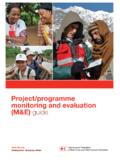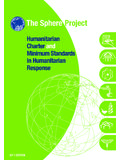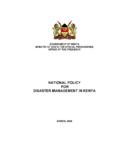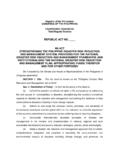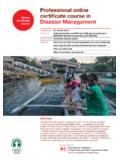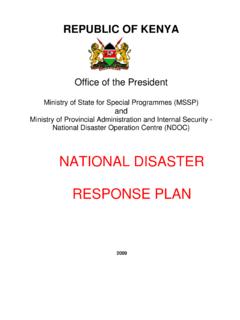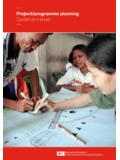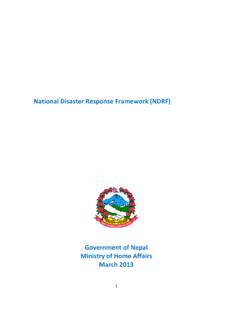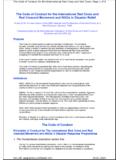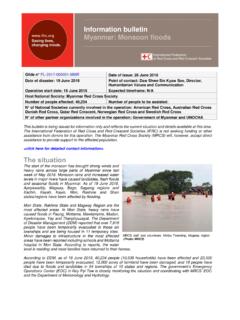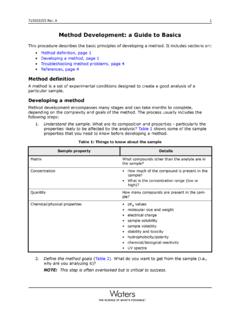Transcription of Baseline Basics 10May2013 - IFRC
1 Baseline Basics (Reviewer s note: I suggest we commission a cartoon conveying that there is not just one way to do a survey. But for now, this one from our library seemed suitable.) May 2013 (living draft) Planning and Evaluation Department (PED), Geneva International Federation of Red Cross and Red Crescent Societies (IFRC) IFRC Planning & Evaluation Department May 2013 2 | Page TABLE OF CONTENTS 1. Purpose & audience of this guide .. 2 2. What is a Baseline ? .. 2 3. Why is Baseline data important? .. 3 4. Is a Baseline study necessary, and if so what kind? .. 4 5. When conduct a Baseline study?
2 5 6. Who conducts a Baseline study? .. 5 7. How to plan for a Baseline study? .. 6 8. Reconstructing Baseline Data .. 11 9. Resources .. 13 1. Purpose & audience of this guide This guide is intended to support NS and other IFRC project1 teams and stakeholders to conduct reliable and useful Baseline studies that help better measure and deliver services to those in need. It is meant to be succinct, but with enough information to practically guide the user to plan for and implement a Baseline study, pointing to additional resources for further reference. Feedback is welcome, and can be sent to 2. What is a Baseline ?
3 A Baseline refers to measurements of key conditions (indicators) before a project begins, from which change and progress can be assessed. Sometimes Baseline data is available, other times a Baseline study is needed to determine Baseline conditions. As this guide highlights, there are a variety of different scenarios for and ways to conduct Baseline studies. The specific methodology will depend on a variety of project-specific factors, ranging from specific indicators to time and budget. 1 Project will be used throughout this guide, but the concepts in this guide apply as well to programs (typically consisting of multiple projects at a larger scale and duration) and other similar service delivery interventions using Baseline studies.
4 Using Baseline data may actually be more common than you think! For example, you may record your weight prior to a diet to monitor your progress and later determine whether your diet made any difference. Recognize the guide to the left? If not, you should! It is the IFRC Project/Programme Monitoring and Evaluation Guide, and it is an important resource to complement this guide, with further information key monitoring and evaluation (M&E) topics. The guide and other IFRC planning, monitoring, evaluation and reporting (PMER) resources can be found at IFRC Planning & Evaluation Department May 2013 3 | Page In addition to Baseline , there are other related terms that are important to understand relative to baselines.
5 Table 1 below defines key concepts useful to understand when working with baselines: Terms Definitions Further explanations Baseline Data that measures conditions (appropriate indicators) before project start for later comparison . Baseline data provides a historical point of reference to: 1) inform program planning, such as target setting, and 2) monitor and evaluation change for program implementation and impact assessment. Baseline Study Data collection and analysis exercise to determine the Baseline conditions (indicators). If resources are invested into a Baseline study, it is important to budget and plan for an endline study of the same Baseline conditions (indicators) using the same methodology for reliable comparison.
6 Needs Assessment2 Exercise to identify if and what needs exist, and inform how to best address such needs. A needs assessment is different from a Baseline study. A needs assessment identifies needs, and informs whether and how to intervene (the project design); A Baseline study measures specific conditions after a project has been designed, based on the indicators ( in the logframe). Data from needs assessments may be used in a Baseline study, but only if it reliably captures the relevant conditions. Evaluation Exercise to reflect upon and judges the worth (value) of what has been done. A Baseline study is not an evaluation, but can be an important part of an evaluation, providing important data to measure change and assess performance.
7 Target The specific, planned level of result to be achieved ( for an indicator) within an explicit timeframe. Targets are critical to motivate the project team, establish clear expectations, and compare with actual performance to assess and adjust project implementation. A Baseline value for an indicator is not a target, but helps to inform realistic target setting. Benchmark A target to based on an existing industry standard, minimum requirement, or best practice. A benchmark can be used to help set a specific indicator target, and to compare and assess the indicator performance (against industry standards).
8 While a Baseline measures the actual conditions (indicators) prior to implementation, a benchmark is an industry-recognized reference point or standard against for the indicator. Like a Baseline measurement, a benchmark can be used to: 1) help set a specific indicator target, 2) compare with and assess indicator performance. However, they are different. For example, a Baseline value for an indicator measuring actual water availability following a disaster may be .5 litres per person per day, while the benchmark is litres, (based on the international Sphere Standards). 3. Why is Baseline data important? Without Baseline data, it can be very difficult to plan, monitor and evaluate future performance.
9 Baseline data help to set achievable and realistic indicator targets for each level of result in a project s design ( logframe), and then determine and adjust progress towards these targets and their respective results. Additional reasons for conducting Baseline studies include: Inform project management decision-making, providing a reference point to determine progress and adjust project implementation to best serve people in need. Assess measurability of the selected indicators and fine tune the systems for future measurement. Uphold accountability, informing impact evaluation to compare and measure what difference the project is making.
10 2 In addition to IFRC s own needs assessment resources, such as vulnerability capacity assessments (VCAs) and the Guidelines for Assessment in Emergencies, readers may be interested in the World Bank s A Guide to Assessing Needs. IFRC Planning & Evaluation Department May 2013 4 | Page Promote stakeholder participation, providing a catalyst for discussion and motivation among community members and project partners on the most appropriate means of action. Shape expectations and communication strategies by assisting by sharpening communication objectives, and focusing content of media materials.
